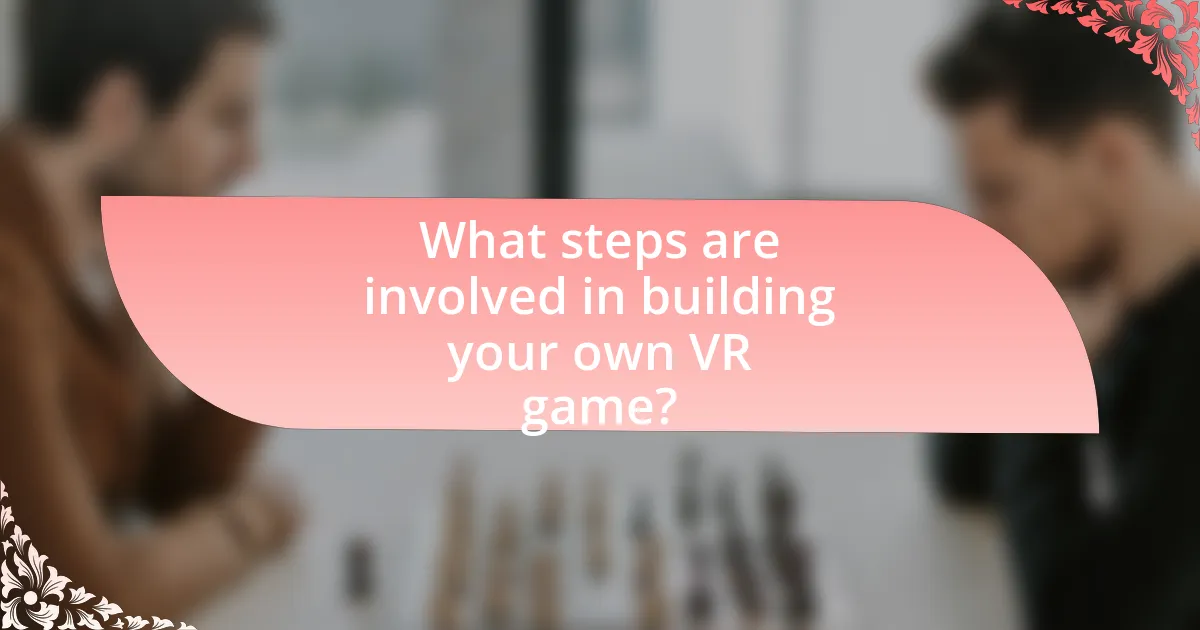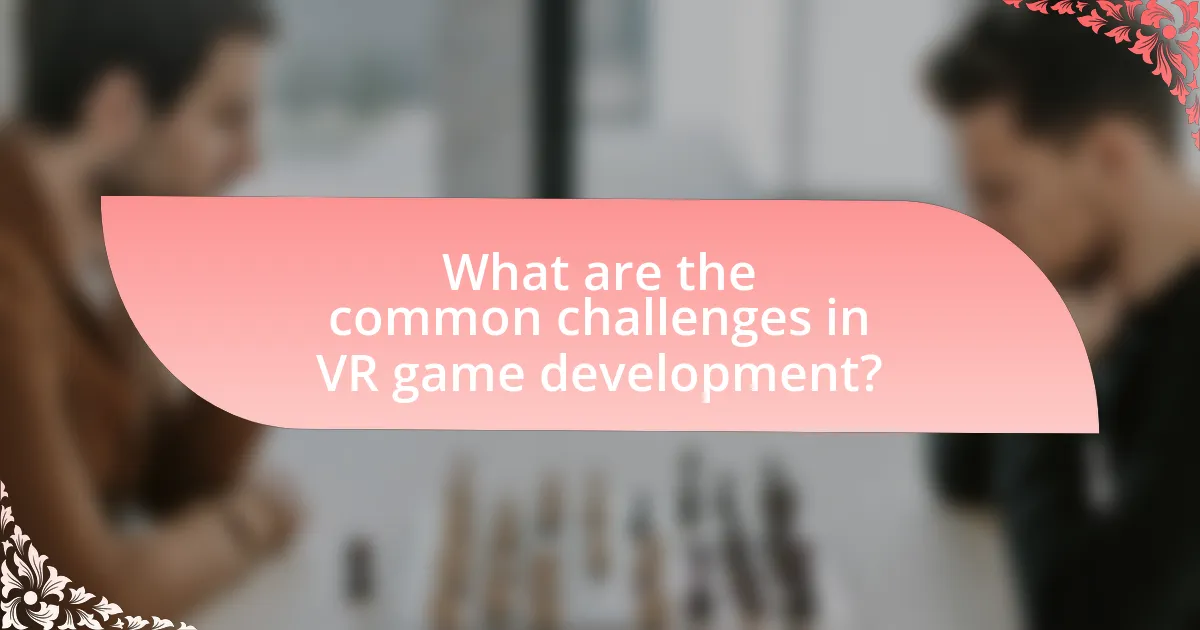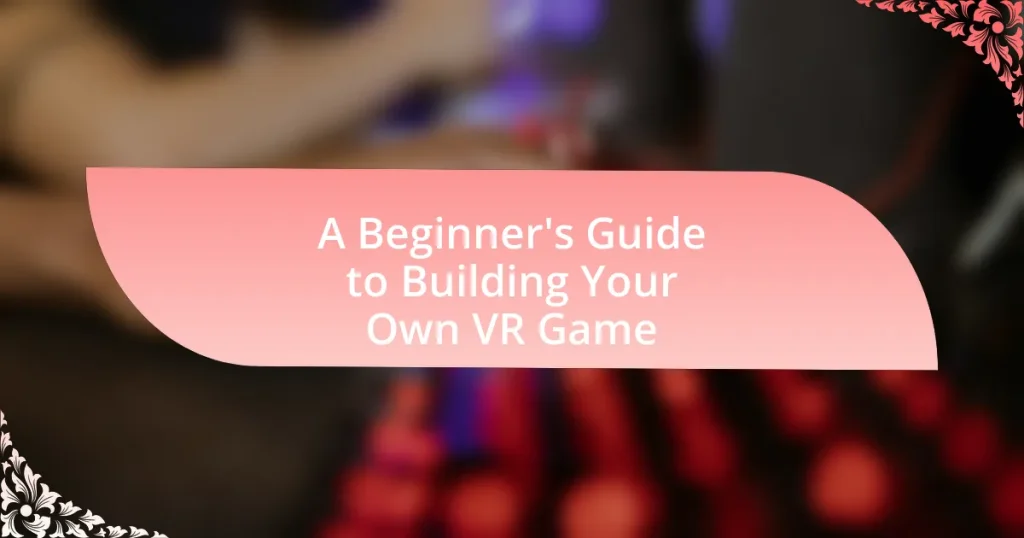A Beginner’s Guide to Building Your Own VR Game provides a comprehensive overview of virtual reality (VR) gaming, detailing the essential technologies, immersive experiences, and key components that differentiate VR games from traditional gaming formats. The article covers the necessary steps for developing a VR game, including conceptualization, design, development, testing, and deployment, while also discussing the importance of user experience and comfort. Additionally, it highlights the skills required for VR game development, common challenges faced, and best practices for testing and refining games, making it a valuable resource for aspiring VR developers.

What is a VR Game?
A VR game is an interactive digital experience that immerses players in a simulated environment using virtual reality technology. This technology typically involves the use of a VR headset, which provides a 360-degree view of the virtual world, allowing players to engage with the environment and interact with objects as if they were physically present. The immersive nature of VR games is supported by advanced graphics, spatial audio, and motion tracking, which enhance the realism and engagement of the gameplay experience.
How do VR games differ from traditional games?
VR games differ from traditional games primarily in their immersive experience, as VR games utilize headsets and motion tracking to create a three-dimensional environment that players can physically interact with. This level of immersion allows players to feel as though they are inside the game world, engaging with it through natural movements and gestures, unlike traditional games that typically rely on a screen and controller for interaction. For example, a study by the University of Southern California found that VR can enhance emotional engagement and presence, leading to a more impactful gaming experience compared to conventional gaming formats.
What technologies are essential for VR gaming?
Essential technologies for VR gaming include head-mounted displays (HMDs), motion tracking systems, and haptic feedback devices. HMDs, such as the Oculus Rift and HTC Vive, provide immersive visual experiences by displaying 3D graphics directly in front of the user’s eyes. Motion tracking systems, like the ones used in the PlayStation VR, enable the detection of the user’s movements and position in real-time, enhancing interactivity. Haptic feedback devices, such as gloves or vests, simulate touch and physical sensations, further immersing players in the virtual environment. These technologies collectively create a comprehensive VR experience, as evidenced by the rapid growth of the VR gaming market, which reached approximately $1.8 billion in revenue in 2021, according to Statista.
Why is immersion important in VR games?
Immersion is crucial in VR games because it enhances the player’s sense of presence and engagement within the virtual environment. This heightened immersion allows players to feel as though they are truly part of the game world, which can lead to a more enjoyable and impactful gaming experience. Research indicates that immersive experiences can increase emotional responses and investment in the game, making players more likely to remember and connect with the narrative and gameplay. For instance, a study published in the journal “Computers in Human Behavior” found that higher levels of immersion in VR environments correlate with increased emotional engagement and satisfaction among players.
What are the key components of a VR game?
The key components of a VR game include immersive environments, interactive gameplay mechanics, user interface design, and hardware compatibility. Immersive environments create a believable virtual world, often utilizing 3D graphics and spatial audio to enhance realism. Interactive gameplay mechanics allow players to engage with the environment and other characters, often through motion tracking and hand controllers. User interface design is crucial for navigation and interaction within the game, ensuring that players can easily understand and control their experience. Hardware compatibility ensures that the game functions seamlessly across various VR headsets and platforms, which is essential for reaching a wider audience. These components collectively contribute to the overall effectiveness and enjoyment of a VR game.
What role do graphics and sound play in VR experiences?
Graphics and sound are crucial components of virtual reality (VR) experiences, as they significantly enhance immersion and user engagement. High-quality graphics create realistic environments that allow users to feel present within the virtual space, while spatial audio provides directional sound cues that enhance the sense of realism and interaction. Research indicates that immersive graphics can increase user satisfaction and emotional response, with studies showing that well-designed visuals can lead to a 30% increase in perceived realism. Similarly, sound design, including ambient sounds and interactive audio elements, has been shown to improve user experience by 40%, making the virtual environment more believable and engaging. Together, graphics and sound work synergistically to create a compelling VR experience that captivates users and encourages prolonged interaction.
How do user interfaces differ in VR games?
User interfaces in VR games differ significantly from traditional gaming interfaces by utilizing immersive, spatial interactions that engage users in a three-dimensional environment. In VR, interfaces often include hand-tracking, gaze-based selection, and gesture controls, allowing players to interact with game elements as if they were physically present. This contrasts with conventional interfaces that rely on 2D screens and input devices like keyboards or controllers. Research indicates that VR interfaces enhance user engagement and immersion, as evidenced by studies showing increased player satisfaction and performance in VR environments compared to non-VR settings.

What steps are involved in building your own VR game?
Building your own VR game involves several key steps: conceptualization, design, development, testing, and deployment.
First, conceptualization requires defining the game’s core idea, mechanics, and target audience. Next, design involves creating the game’s visual elements, user interface, and level layouts, often using tools like Unity or Unreal Engine, which are widely recognized in the industry for VR development.
Development follows, where programmers write code to bring the game to life, integrating 3D models, animations, and sound. This phase often utilizes VR-specific SDKs, such as Oculus SDK or SteamVR, to ensure compatibility with VR hardware.
Testing is crucial to identify and fix bugs, ensuring a smooth user experience. This step often includes playtesting with real users to gather feedback. Finally, deployment involves publishing the game on platforms like Oculus Store or Steam, making it accessible to players.
These steps are essential for creating a functional and engaging VR game, as evidenced by the success of numerous indie VR titles that have followed similar processes.
How do you choose the right game engine for VR development?
To choose the right game engine for VR development, evaluate the engine’s compatibility with VR hardware, performance capabilities, and available features. Popular engines like Unity and Unreal Engine support a wide range of VR devices and offer robust tools for creating immersive experiences. Unity, for instance, provides extensive documentation and a large community, making it accessible for beginners. Unreal Engine excels in high-fidelity graphics, which is crucial for VR immersion. Additionally, consider the engine’s support for VR-specific functionalities, such as spatial audio and motion tracking, which enhance user experience.
What are the most popular game engines for VR?
The most popular game engines for VR are Unity and Unreal Engine. Unity is widely used due to its user-friendly interface, extensive asset store, and strong community support, making it ideal for beginners. Unreal Engine, known for its high-quality graphics and robust performance, is favored for more complex and visually demanding VR projects. Both engines support various VR platforms, including Oculus Rift, HTC Vive, and PlayStation VR, which enhances their accessibility and versatility in the VR development landscape.
How do the features of a game engine impact VR development?
The features of a game engine significantly impact VR development by determining the performance, usability, and overall experience of virtual reality applications. Game engines like Unity and Unreal Engine provide essential tools such as real-time rendering, physics simulation, and support for VR hardware, which are crucial for creating immersive environments. For instance, Unity’s built-in VR support allows developers to easily integrate head tracking and motion controls, enhancing user interaction. Additionally, the optimization features in these engines, such as level of detail (LOD) management and occlusion culling, are vital for maintaining high frame rates, which is critical in VR to prevent motion sickness. Therefore, the specific capabilities of a game engine directly influence the quality and feasibility of VR projects.
What skills do you need to develop a VR game?
To develop a VR game, you need skills in programming, 3D modeling, and user experience design. Programming skills are essential for coding the game mechanics and interactions, often using languages like C# or C++. Proficiency in 3D modeling allows you to create immersive environments and characters, typically using software such as Blender or Maya. User experience design skills ensure that the game is intuitive and engaging for players, focusing on how users interact with the VR environment. These skills are critical as they directly impact the functionality, aesthetics, and overall enjoyment of the VR game.
How important is programming knowledge for VR game development?
Programming knowledge is crucial for VR game development. It enables developers to create interactive and immersive experiences by writing the code that drives game mechanics, graphics, and user interactions. Without programming skills, developers may struggle to implement essential features, optimize performance, or troubleshoot issues, which are vital for delivering a high-quality VR experience. For instance, popular VR platforms like Unity and Unreal Engine require programming languages such as C# and C++ for effective game development. Thus, a solid understanding of programming is fundamental for anyone looking to succeed in the VR game development field.
What design skills are beneficial for creating VR environments?
Creating VR environments benefits from skills in 3D modeling, user interface design, and spatial awareness. 3D modeling skills enable designers to create realistic and immersive environments, essential for user engagement. User interface design skills ensure that interactions within the VR space are intuitive and accessible, enhancing the overall user experience. Spatial awareness is crucial for understanding how users navigate and interact within a three-dimensional space, which directly impacts the effectiveness of the VR environment. These skills collectively contribute to the development of engaging and functional VR experiences.

What are the common challenges in VR game development?
Common challenges in VR game development include hardware limitations, user experience design, and motion sickness. Hardware limitations arise from the need for high-performance graphics and processing power to create immersive environments, which can restrict accessibility for some users. User experience design is critical, as developers must ensure intuitive controls and interactions that accommodate various user preferences and physical capabilities. Motion sickness is a significant concern, as it can result from poor frame rates or mismatched sensory inputs, affecting player comfort and enjoyment. Addressing these challenges requires careful planning and testing to create a successful VR experience.
How can you overcome technical limitations in VR?
To overcome technical limitations in VR, developers can optimize performance through efficient coding practices and hardware upgrades. Efficient coding reduces resource consumption, allowing for smoother experiences even on lower-end devices. Upgrading hardware, such as using more powerful GPUs or increasing RAM, enhances the overall performance and visual fidelity of VR applications. Additionally, implementing techniques like level of detail (LOD) management and occlusion culling can significantly improve rendering efficiency, as these methods reduce the graphical load by only rendering what is necessary for the user’s view. These strategies are supported by industry practices, as seen in successful VR titles that prioritize performance optimization to deliver immersive experiences.
What are the common performance issues in VR games?
Common performance issues in VR games include low frame rates, latency, motion sickness, and graphical artifacts. Low frame rates, typically below 90 frames per second, can lead to a choppy experience, causing discomfort and reducing immersion. Latency, or the delay between user input and visual response, can disrupt the sense of presence and lead to motion sickness. Additionally, graphical artifacts such as texture pop-in or aliasing can detract from visual quality, impacting user experience. These issues are often exacerbated by hardware limitations, such as insufficient processing power or inadequate graphics capabilities, which can hinder the overall performance of VR applications.
How do you ensure user comfort and prevent motion sickness?
To ensure user comfort and prevent motion sickness in VR games, developers can implement techniques such as maintaining a stable frame rate, using a comfortable field of view, and incorporating user-controlled movement options. A stable frame rate of at least 90 frames per second is recommended to reduce latency and enhance immersion, as studies show that lower frame rates can lead to discomfort and nausea. Additionally, a field of view between 90 to 110 degrees can help users feel more at ease, as wider fields can cause disorientation. Allowing users to control their movement, such as through teleportation or gradual acceleration, can also mitigate motion sickness, as research indicates that user agency in movement reduces the likelihood of discomfort.
What are the best practices for testing and refining your VR game?
The best practices for testing and refining your VR game include conducting user testing, gathering feedback, and iterating on design based on that feedback. User testing allows developers to observe how players interact with the game, identifying usability issues and areas for improvement. Gathering feedback through surveys or interviews provides insights into player experiences and preferences, which can inform design decisions. Iterating on design involves making adjustments based on user feedback and retesting to ensure that changes enhance the overall experience. These practices are supported by studies showing that iterative testing can significantly improve user satisfaction and engagement in VR environments.
How can user feedback improve your VR game design?
User feedback can significantly enhance VR game design by providing insights into player experiences and preferences. This feedback allows developers to identify usability issues, gameplay mechanics that may not resonate, and areas for improvement in immersion and interaction. For instance, a study by the International Journal of Human-Computer Interaction found that incorporating user feedback during the design phase led to a 30% increase in user satisfaction ratings. By actively engaging with players and iterating on their suggestions, developers can create a more engaging and enjoyable VR experience that aligns with user expectations.
What tools can assist in the testing phase of VR development?
Tools that can assist in the testing phase of VR development include Unity, Unreal Engine, and SteamVR. Unity provides a robust environment for creating and testing VR applications, offering built-in support for VR devices and extensive testing tools. Unreal Engine also supports VR development with its high-fidelity graphics and testing capabilities, allowing developers to simulate various VR scenarios. SteamVR is essential for testing compatibility across different VR hardware, ensuring that applications function correctly on multiple platforms. These tools are widely used in the industry, demonstrating their effectiveness in facilitating the testing process during VR development.
What tips can help beginners succeed in VR game development?
To succeed in VR game development, beginners should focus on mastering the fundamentals of 3D design and programming. Understanding tools like Unity or Unreal Engine is crucial, as these platforms provide essential resources for creating immersive experiences. Additionally, beginners should prioritize user experience by designing intuitive controls and minimizing motion sickness, which is a common issue in VR. Research indicates that 70% of VR users experience discomfort due to poor design choices, highlighting the importance of user-centric development. Engaging with the VR community through forums and online courses can also provide valuable insights and support, further enhancing a beginner’s learning curve.
How can you stay updated with the latest VR trends and technologies?
To stay updated with the latest VR trends and technologies, regularly follow industry news through reputable sources such as VRFocus, UploadVR, and TechCrunch. These platforms provide timely articles and insights on advancements in virtual reality. Additionally, participating in online forums and communities, such as Reddit’s r/virtualreality or VR-specific Discord servers, allows for real-time discussions and sharing of information among enthusiasts and professionals. Attending industry conferences like the Game Developers Conference (GDC) or the Augmented World Expo (AWE) also offers opportunities to learn about cutting-edge developments directly from experts and innovators in the field.
What resources are available for learning VR game development?
Online platforms such as Udemy, Coursera, and LinkedIn Learning offer comprehensive courses on VR game development. These platforms provide structured learning paths that cover essential topics like Unity and Unreal Engine, which are widely used in the industry. Additionally, the official documentation and tutorials from Unity and Unreal Engine serve as valuable resources, offering in-depth guidance on specific features and tools. Books like “Learning Virtual Reality” by Tony Parisi and “Unity Virtual Reality Projects” by Jonathan Linowes also provide practical insights and projects to enhance understanding. Furthermore, communities on forums like Reddit and Stack Overflow facilitate peer support and knowledge sharing among aspiring VR developers.


